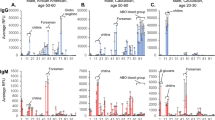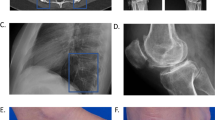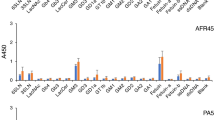Abstract
Grubb and Laurell1 and others have demonstrated that some human sera contain a genetically determined factor capable of inhibiting the ability of serum from selected rheumatoid arthritic patients (RA serum) to agglutinate Rh(+) cells coated with selected incomplete anti-D sera. They called this factor Gma and showed that its presence is due to a dominant gene. Thus far various investigators have tested 2,635 Europeans and found that 56.96 per cent were Gm(a+)2. Grubb and Laurell1 found 95 per cent of 74 Eskimos to be Gm(a+), and Steinberg and Giles2 found 98 per cent of 98 American Negroes to be Gm(a+).
This is a preview of subscription content, access via your institution
Access options
Subscribe to this journal
Receive 51 print issues and online access
$199.00 per year
only $3.90 per issue
Buy this article
- Purchase on Springer Link
- Instant access to full article PDF
Prices may be subject to local taxes which are calculated during checkout
Similar content being viewed by others
References
Grubb, R., and Laurell, A. B., Acta Path. Microb. Scand., 39, 390 (1956).
Reviewed in Steinberg, A. G., and Giles, Brenda Dawn, Amer. J. Human Genet. (in the press).
Harboe, M., and Lundevall, J., Acta Path. Microb. Scand., 45, 357 (1959).
Harboe, M., Nature, 183, 1468 (1959).
Author information
Authors and Affiliations
Rights and permissions
About this article
Cite this article
STEINBERG, A., STAUFFER, R. & FUDENBERG, H. Distribution of Gma and Gm-like among Javanese, Djuka Negroes, and Oyana and Carib Indians. Nature 185, 324–325 (1960). https://doi.org/10.1038/185324a0
Issue Date:
DOI: https://doi.org/10.1038/185324a0
This article is cited by
-
Gm-Frequenzen und Verwertbarkeit des Gm-Systems in Paternit�tsgutachten
Deutsche Zeitschrift f�r die Gesamte Gerichtliche Medizin (1963)
-
The Gm a Factor in Japanese
Nature (1961)
-
Die Gma-Frequenz in Berlin mit Angaben über die Häufigkeit geeigneter Anti-Rh-Seren und sogenannter praezipitierender Seren
Blut Zeitschrift für die Gesamte Blutforschung (1961)
-
Possible Origins of the Anti-Gm Sera
Nature (1960)
-
Evidence for a Gm ab Allele in the Gm System of American Negroes
Nature (1960)
Comments
By submitting a comment you agree to abide by our Terms and Community Guidelines. If you find something abusive or that does not comply with our terms or guidelines please flag it as inappropriate.



